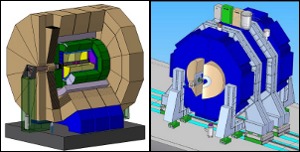 |
 |
|||||||||||||
|
|||||||||||||
|
|||||||||||||
ILD and SiD, two of the three detector concepts that submitted Letters of Intent, have been recommended for validation to Research Director Sakue Yamada by the International Detector Advisory Group (IDAG), chaired by Michel Davier. At their recent meeting in Hamburg, the ILC's Steering Committee endorsed the IDAG recommendations. This means that the R&D collaborations working on detector technologies and prototypes for the two ILC detector concepts ILD, the International Large Detector concept, and SiD, the Silicon Detector Design Study, will continue under full steam in their work towards the best design for detectors to understand collisions at the future ILC. The third detector concept that submitted an LOI, called '4th', was not validated. However, IDAG recommended that R&D on dual readout calorimetry done for 4th in a collaboration of many institutes should be supported in view of its potential for higher energy colliders. The fact that the detector concepts have been validated does not mean that the concepts are final or that ILD and SiD will be the two detectors selected for the ILC. The idea is to demonstrate that these detectors are capable to perform the desired physics researches at the time when the project is proposed. Where there are parallel R&D projects studying the same subdetector under different configurations, all included in the Letters of Intent, at least one configuration has to be proven to be feasible and realistic to form a baseline detector design. Also new technologies may emerge by the time ILC construction begins.
Conclusion from the IDAG report:
"The ILD and SiD concepts are validated and should be considered for the next phase of detailed baseline studies together with GDE. They constitute a solid basis for the two-detector push-pull concept with a large amount of complementarity in their design and expected performances. Tracking options are very different, and even if their baseline choices for calorimetry are similar, their implementation and exploitation will ensure robustness in the ILC physics results. They should both demonstrate a feasible solution at the end of the TDR phase of the accelerator." Even though the ILC will only have one point where particles collide it will nevertheless feature two detectors, thanks to a new concept called push-pull: while one detector is pushed into the collision zone to take data, the other is pulled out and can be serviced and checked. Moving and shielding the detectors is quite a challenge, and detector concepts were asked to submit ideas to address these challenges in their Letters of Intent (LOI), following the ILC recommendations on Functional Requirements on the Design of the Detectors and the Interaction Region of an e+e- Linear Collider with a Push-Pull Arrangement of Detectors which was published this April. The advisory group selected ILD and SiD on more than just the basis of the LOI: each concept group was invited for detailed discussions, asked to clarify open points in the LOI and submit simulations for specific physics events so that IDAG could make direct comparisons. The IDAG report also includes a set of recommendations for the coming phase of detector development – the concepts now have to show that their ideas actually work, and that their simulations are correct before the detailed Baseline Design Report is published in 2012. -- Barbara Warmbein Read also our special NewsLine issue from May 2009 about ILC concept detector validation. |
|||||||||||||
| © International Linear Collider |
